Pinus L. (Pinaceae)
Description
This section is from the book "Woody Plants In Winter", by Earl L. Core, Nelle P. Ammons. Also available from Amazon: Woody Plants in Winter.
Pinus L. (Pinaceae)
Evergreen trees with 2 kinds of leaves, the primary ones solitary, scalelike, deciduous the first year, the secondary forming the ordinary foliage, narrowly linear, arising in the axils of the primary in bundles (fascicles) of 2 to 5, persistent for several years. Cones requiring 2 years for ripening, those of the first year small and green in winter, maturing the second autumn but often persisting for several years, usually armed with prickles or spines.
a. | Leaves 5 in a fascicle | 1. | P. strobus |
a. | Leaves 2 or 3 in a fascicle | ||
b. Leaves 3 in a fascicle | 7. | P. rigida |
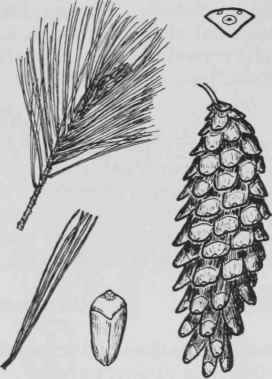
Fig. 9. Pinus strobus.
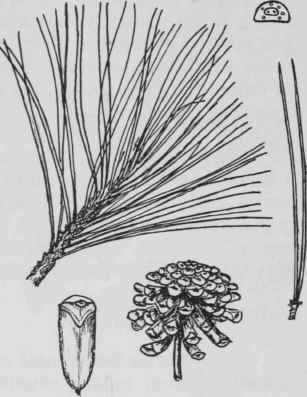
Fig. 10. Pinus resinosa.
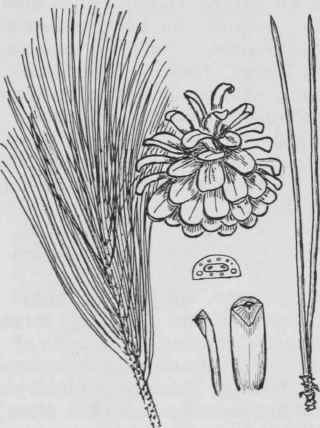
Fig. II. Pinus nigra.
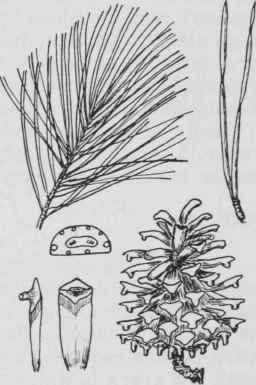
Fig. 12. Pinus sylvesrris.
b. | Leaves 2 in a fascicle, or in 2's and 3's | ||
c. Cone-scales unarmed | |||
d. Leaves 2-4 cm. long; cones often curved | 9. | P. banksiana | |
d. Leaves 3-17 cm. long; cones usually not curved | |||
e. Leaves 7-17 cm. long; cone-scales without a central protuberance | 2. | P. resinosa | |
e. Leaves 3-7 cm. long; cone-scales with a tall central protuberance | 4. | P. sylvestris | |
c. Cone-scales armed | |||
d. Leaves in 2's and (often) 3's on the same tree | |||
e. Leaves 7-13 cm. long; prickle weak | 5. | P. echinata | |
e. Leaves 3-7 cm. long; prickle very strong | 8. | P. pungens | |
d. Leaves 2 in a fascicle | |||
e. Leaves 2-4 cm. long | 9. | P. banksiana | |
e. Leaves 4-17 cm. long | |||
f. Leaves 4-8 cm. long; native tree | 6. | P. virginiana | |
f. Leaves 7-17 cm. long; introduced tree | 3. | P. nigra |
1. _P. strobus L. White Pine. A large forest tree 20-50 m. high, with a trunk diameter of 6-13 dm.; bark on the young branches smooth, on the old trunks divided by shallow grooves into wide flat-topped ridges; leaves in 5's, 7-13 cm.long, slender, marked with white lines, the fascicle-sheaths deciduous; mature cones slender, cylindrical, somewhat curved, 1-1. 5 dm. long, the scales unarmed. Rich woods, Newfoundland to Manitoba, south to Iowa and the mountains of Georgia and Tennessee (Fig. 9).
2. P. resinosa Ait. Red Pine. A tall forest tree reaching a maximum height of 50 m. and a diameter of 15 dm.; bark reddish, rather smooth; leaves 2 in a fascicle, dark green, 9-16 cm. long; mature cones ovoid-conical, 5 cm. long; scales unarmed. Dry woods, Newfoundland to Manitoba, south to Minnesota and the mountains of West Virginia; most common about the Great Lakes and in New England (Fig. 10).

Fig. 13. Pinus echinata.
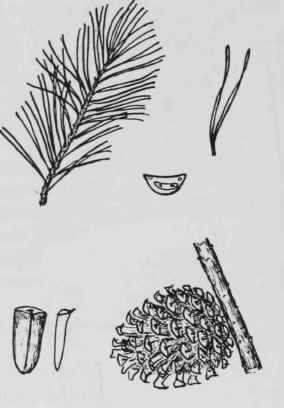
Fig. 14. Pinus virginiana.
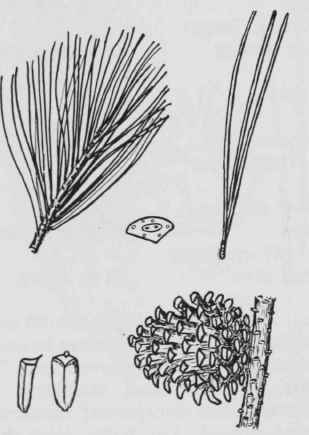
Fig. 15. Pinus rigida.

Fig. 16. Pinus pungens.
3. P. nigra Arnold.Austrian Pine. A tree 30-50 m. high; bark dark brown to black; buds silvery or light brown; branchlets usually light brown; leaves stiff, 9-16 cm. long, dark green; cones 5-8 cm. long, the scales with a short prickle on the umbo. Introduced from Europe and spreading slightly from cultivation (Fig. 11.)
4. P. sylvestris L. Scotch Pine. A timber tree up to 40 m. high; bark gray; leaves in 2's, bluish or grayish-green, 3-7 cm. long; cones 3-6 cm. long, slender, conic, reflexed, the scales thickened, rhombic, with a central protuberance but not prickly. Introduced from Europe, much cultivated, and naturalized (Fig. 12).
5. P. echinata Mill. Shortleaf Pine. Yellow Pine. A straight tree 15-45 m. high, with a trunk diameter of 6-10 dm.; bark broken into large more or less rectangular plates; leaves mostly in 2's, but also in 3's on the same tree, 7-13 cm. long, slender, flexible; mature cones ovoid, about 5 cm. long; scales armed with a minute weak prickle. Dry or sandy soil, Florida to Texas, north to New York, Ohio, and Oklahoma (Fig. 13).
6. P. virginiana Mill. Scrub Pine. Virginia Pine. Jersey Pine. A straggling tree 5-20 m. high, trunk diameter 3-6 dm.; branches spreading or drooping; bark with shallow fissures and dark brown loose scales; leaves in 2's, 4-8 cm. long, twisted, gray-green; mature cones few, oblong-conic, 3-7 cm. long;scales with a straight or curved slender prickle. Barrens and sterile soil, Georgia to Arkansas, north to Virginia, New Jersey, New York and Indiana (Fig. 14).
7. P. rigida Mill. Pitch Pine. A tree 10-25 m. high, with very rough dark bark and hard resinous ("pitchy") wood; leaves in 3's, 5-12 cm. long, rigid, dark green; mature cones ovoid-conical or ovoid, 3-9 cm. long, often clustered; scales thickened at the apex, bearing a short thick curved prickle. Sandy or barren soil, Maine to Ontario, south to Ohio and the mountains of Georgia and Tennessee (Fig. 15).
8. P. pungens Lamb. Table Mountain Pine. A rather small tree, 6-20 m. high, and with trunk diameter of 10 dm.; bark broken by fissures into irregular red-brown plates, leaves in 2's (sometimes also in 3's), stiff, 3-6 cm. long, blue-green; mature cones clustered, ovoid, 5-10 cm. long, hanging on for many years; scales very thick and woody, armed with a strong hooked spine 4-5 mm. long. Uplands, New Jersey and Pennsylvania to Georgia and Tennessee (Fig. 16).

Fig. 17. Pinus banksiana.
9. P. banksiana Lamb. Jack Pine. A low tree usually 5-20 m. high, 3-4 dm. in diameter; bark thin, brown, reddish or gray, irregularly broken into scaly ridges; leaves in 2's, short and thick, 2-4 cm. long, divergent; cones conical, oblong, usually curved, 3-5 cm. long, the scales smooth or with a minute prickle. Barren or rocky soil, Quebec to Mackenzie, south to Alberta, Michigan and New York (Fig. 17).
Continue to:


